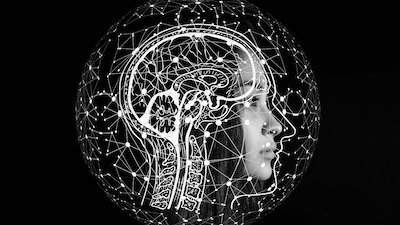Synapses Speak
Dramatic difference found between human and chimpanzee brains.
News Source
- Science: “Human Brains Wire Up Slowly but Surely”
The human brain, compared age-for-age with chimpanzee and macaque brains, is wired very differently, according to a report in the February 2 online edition of Genome Research. To determine how species with some genetic similarity—such as humans and chimps—can be intellectually so different, researchers examined gene expression in two key areas of the brain. They hypothesized that it was switching genes on and off that produced dramatic differences in intellect.
Brain development is known to continue after birth for a period of time. Formation of new synapses requires expression of certain genes, and when genes are being expressed, messenger RNA (mRNA) is produced. To see if species-specific genetic expression makes ongoing postnatal development possible, researchers quantified mRNA in brain tissue from humans, chimpanzees, and macaques of various ages. They studied tissue from the prefrontal cortex—the part of the brain essential to human social behavior and reasoning—as well as the cerebellum, which is important for balance.
“We might have discovered one of the differences that makes human brains work differently from chimpanzees and macaques,” says lead researcher Philipp Khaitovich. Of the 12,000 genes whose mRNA they assayed, the researchers found 702 genes in the prefrontal cortex of humans have unique age-related patterns of expression. The most drastic differences occurred in genes associated with synapse formation. The amount of mRNA was very high in newborns of all the species, but gene expression markers for prefrontal cortex synapses in humans remained high until age five. The mRNA for comparable genes in the chimps and macaques, however, dropped soon after birth.
The team also counted the number of synapses in electron micrographs of brain tissue. They found the number of synapses rose rapidly after birth in all three species, but the number of synapses continued to increase in humans, peaking at age four. Adjusting data for the difference in lifespan and noting humans have a longer childhood than chimps and macaques, Khaitovich comments, “Humans have much more time to form synaptic connections.” The differences were not significant in the cerebellar tissue.
This is an absolutely fascinating study that will have great importance for advancing understanding of human disorders of early brain development as well as illuminating the evolutionary changes in neural development.
UC-San Diego neurologist Eric Courchesne has found autistic children’s brains grow rapidly, possibly too rapidly to form synapses properly. He therefore comments, “This is an absolutely fascinating study that will have great importance for advancing understanding of human disorders of early brain development as well as illuminating the evolutionary changes in neural development.”
Evolutionary scientists claim genetic similarity proves common ancestry. Nevertheless, they have difficulty explaining how dramatic intellectual differences evolved in only a few million years. They believe this study offers insight into the mechanism of such intellectual evolution.
Chimps and humans are commonly thought to share 96-98% similarity in DNA sequences that align between them. (Some of the apparent similarity is an artifact of the biases and limitations of the technology involved in genome sequencing, and the similarity is probably closer to 86-89%.) It is not surprising to find many of the same genes (coding for proteins) are used in similar organisms, but shared genes do not prove common ancestry. They are simply consistent with a common Designer. The mechanisms regulating gene expression are part of God’s distinctive created designs for humans and each kind of animal.
This study highlights one of the differences in God’s design for human beings. But describing differences does not reveal how those differences came to be. Nothing in the study shows that evolution happened or even how it could happen. God gives us His eyewitness account of our origins in the book of Genesis. He created man in His own image from dust, not from a pre-existing living creature (see Genesis 2:7), and we know that humans and chimps are vastly different physically, mentally, and spiritually. This study gives us some insight into the physical equipment that makes those differences possible.
Further Reading
- If Human and Chimp DNA Are So Similar, Why Are There So Many Physical and Mental Differences Between Them?
- Are Humans and Chimps Related?
- “The Search for the Historical Adam” and Population Genomics
- Chimp Genome Sequence Very Different from Man
- Greater Than 98% Chimp/Human DNA Similarity? Not Any More.
- How Genomes are Sequenced and Why it Matters: Implications for Studies in Comparative Genomics of Humans and Chimpanzees
For More Information: Get Answers
Remember, if you see a news story that might merit some attention, let us know about it! (Note: if the story originates from the Associated Press, FOX News, MSNBC, the New York Times, or another major national media outlet, we will most likely have already heard about it.) And thanks to all of our readers who have submitted great news tips to us. If you didn’t catch all the latest News to Know, why not take a look to see what you’ve missed?
(Please note that links will take you directly to the source. Answers in Genesis is not responsible for content on the websites to which we refer. For more information, please see our Privacy Policy.)
Recommended Resources

Answers in Genesis is an apologetics ministry, dedicated to helping Christians defend their faith and proclaim the good news of Jesus Christ.
- Customer Service 800.778.3390
- © 2024 Answers in Genesis







